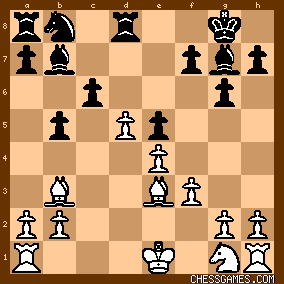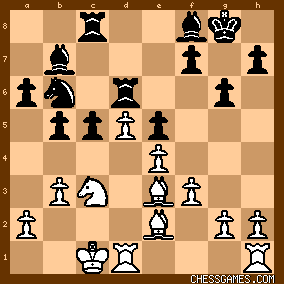keypusher: Part I of II
Here are some excerpts from Botvinnik's own notes, which are an interesting to compare to the computer lines. Botvinnik saw 28.f4, but decided not to play it for practical reasons. Many of Tal's moves that the computer scores as errors Botvinnik passes over in silence, probably in part because they seemed natural in light of the plans Tal had chosen. After 6....e5:
<Whereas after the 10th game my opponent was definitely aiming for a draw, after his victory in the 12th game he was in an aggressive mood, as indicated by his choice of opening. Taking this into account, White takes a psychologically correct decision: first of all, he exchanges the queens.> After 11.Bc4
<Inviting Black to choose the variation 11....cxd5 12.Bxd5 Nc6, which was known from the game Boleslavsky vs Najdorf, 1953. Alas, such a prosaic decision does not suit Tal, and he plays for complications, i.e. for the worsening of his own position.> 
click for larger view13.0-0-0 <If 13.Rc1, according to analysis by Boleslavsky, Black gets the better game by 13....a5 (avoiding traps such as 13....cxd5 14.Rc7 Rd7 15.Rxb7, or 13....Rd7 14.Ne2 cxd5 15.Bxd5 Bxd5 16.Rc8+ Bf8 17.exd5). Therefore White sets a more substantial threat -- a positional one.> 13....c5
<To my surprise, Tal makes the position a closed one, which is not in keeping with his style. Of course he should not have left White with a protected passed pawn and restricted the possibilities of his queen's bishop. After 13....a5! 14.dxc6 Nxc6 15.Rxd8+ Rxd8 a roughly equal position would have been reached.> 14.Bc2
<White's plan was not difficult to find. It was successfully implemented in a similar position in a training game Boleslavsky-Botvinnik (Voronovo 1952), and consisted in the preparation of an attack on the black pawn chain by b2-b3 and a2-a4. It is surprising that, although White does not conceal his intentions, my opponent essentially does not even attempt to counter them.> Botvinnik apparently means this game Boleslavsky vs Botvinnik, 1952, which is a Semi-Slav, but winds up with essentially the same pawn formation. Botvinnik always thought in terms of structures and systems, not openings. After 16....a6.
<Perhaps the losing move. The bishop at b7 is shut out of play for a long time, and more importantly, White is able to carry out his idea without hindrance. Black should have played 16....b4 17.Na4 c4 followed by ...Ba6, leading to unclear complications. > After 19....Rd6
<This move creates the concrete threat of 20....b4 21.Nb1 c4 (the knight on b6 is defended) but the rook on d6 is no ornament to Black's position.> 
click for larger view20.Kb2
<Now the threat is parried: if 20....b4 21.Nb1 c4 22.bxc4 Nxc4+ 23.Bxc4 Rxc4 24.Rc1 White breaks through on the c-file.> After 22....bxa4
<Since after 22....b4 23.Nb1 Black is left with numerous weaknesses, he takes another decision, also, however, a painful one: he opens the b-file, which soon will be occupied by White.> | 




